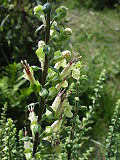Teucrium scorodonia: Difference between revisions
CSV import |
CSV import |
||
| Line 23: | Line 23: | ||
[[Category:Lamiaceae]] | [[Category:Lamiaceae]] | ||
{{Flora-stub}} | {{Flora-stub}} | ||
<gallery> | |||
File:Valse_salie_IMG_0951.JPG|Teucrium scorodonia | |||
File:Gardenology.org-IMG_2822_rbgs11jan.jpg|Teucrium scorodonia | |||
File:Lamiaceae_-_Teucrium_scorodonia-1.JPG|Teucrium scorodonia | |||
File:Teucrium_scorodonia_08_ies.jpg|Teucrium scorodonia | |||
File:Teucrium_scorodonia_2005.07.11_09.12.35.jpg|Teucrium scorodonia | |||
File:Lamiaceae_-_Teucrium_scorodonia.JPG|Teucrium scorodonia | |||
</gallery> | |||
Latest revision as of 11:11, 18 February 2025
Teucrium scorodonia, also known as Wood Sage or Wood Germander, is a species of flowering plant in the mint family Lamiaceae. It is native to Europe and North Africa, and has been introduced to other parts of the world, including North America and Australia.
Description[edit]
Teucrium scorodonia is a perennial herb that grows up to 1 meter tall. The leaves are opposite, oval to lanceolate, and have a serrated margin. The flowers are small, yellow-green, and borne in terminal spikes. The plant has a strong, distinctive smell, similar to that of garlic.
Distribution and habitat[edit]
Teucrium scorodonia is native to Europe and North Africa. It has been introduced to other parts of the world, including North America and Australia. It is typically found in dry, open woodlands and heathlands.
Uses[edit]
Teucrium scorodonia has been used in traditional medicine for its antiseptic, astringent, and tonic properties. It has also been used as a flavoring in alcoholic beverages.
Cultivation[edit]
Teucrium scorodonia is a hardy plant that prefers well-drained soil and a sunny position. It can be propagated by seed or by division in spring or autumn.
Conservation status[edit]
Teucrium scorodonia is not currently considered to be at risk of extinction. However, like all wild plants, it is subject to habitat loss and other threats.
References[edit]
<references />
![]()
This flora-related article is a stub. You can help WikiMD by expanding it.
-
Teucrium scorodonia
-
Teucrium scorodonia
-
Teucrium scorodonia
-
Teucrium scorodonia
-
Teucrium scorodonia
-
Teucrium scorodonia





